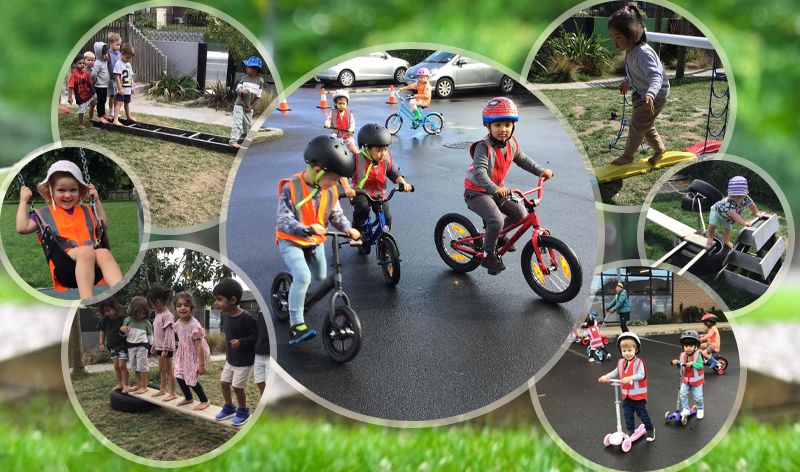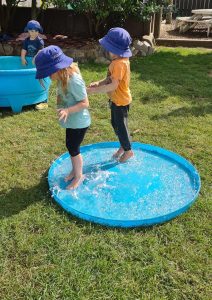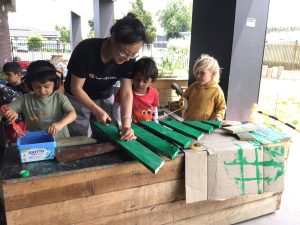Why Risk Play is Important and How it can Boost Your Child’s Learning Abilities?

Many of us may find it challenging to permit risky play to happen. Most parents automatically want to reduce risk in order to protect their children.
Risky Play is doing something exciting despite being uncertain rather than taking unnecessary risks. Depending on their age and comfort level, every child approaches risky play in a different way. When a toddler engages in unsafe play, they may stand on one foot, whereas a preschooler may climb a step stool to reach for something. Children are self-aware; they will not purposely put themselves in danger. Watch your youngster play and experiment with introducing safe hazards during their playtime.
What is Risky Play and why does it matter?
Kids can explore their potential, challenge their limits, and experience an exhilarating thrill through risky play, which frequently involves physical activities like climbing, jumping, and sprinting, which is essential to a child’s growth. Although it may seem paradoxical to let children take physical risks, research has shown that doing so can help them learn how to assess and manage risk in real-world situations.
Here are a few justifications for why it’s crucial:-
 Physical Development: Children have the chance to improve their balance, coordination, strength, and physical skills through risky play. They can test their limitations, sharpen their motor skills, and develop self-assurance in their physical prowess.
Physical Development: Children have the chance to improve their balance, coordination, strength, and physical skills through risky play. They can test their limitations, sharpen their motor skills, and develop self-assurance in their physical prowess.
Emotional and Cognitive Development: Playing at risk encourages youngsters to become emotionally resilient and learn how to solve problems and make decisions. It empowers children to weigh risks, form opinions, and deal with anxiety. Children get the ability to overcome obstacles, increase their self-confidence, and gain a sense of autonomy through these experiences.
Overcoming Anxieties: Risky play offers a supervised environment where kids can confront and get over anxieties in a supportive environment. Children can acquire resilience, overcome anxiety, and have a healthier relationship with risk and uncertainty by introducing them to manageable dangers gradually.
Risk-taking play fosters imagination, creativity, and the capacity for problem-solving. It enables kids to design their own problems, develop fresh games, and discover the limits of their own talents. Risky play is good for kids, but it should always be tempered with the right safety precautions and adult supervision, it’s crucial to remember.
Benefits of Risky Play for Early Childhood Development:
 Young children’s physical play may be where the phrase “risky play” first appeared. Children can develop risk management skills through risk-taking and critical thought through risky play.
Young children’s physical play may be where the phrase “risky play” first appeared. Children can develop risk management skills through risk-taking and critical thought through risky play.
Risk-taking play is crucial for young children’s healthy growth. Children can learn to take risks, evaluate their surroundings, and build problem-solving abilities through dangerous play. Children benefit from risky play because it gives them the chance to explore their surroundings, develop their motor skills, and increase their strength and coordination. The importance of risky play in a child’s early growth cannot be overstated.
Social Development: Risky play frequently entails interaction with peers, which fosters social growth. Children engage in shared dangerous experiences to develop their communication, negotiation, cooperation, and collaboration skills. They learn social skills, empathy, and an appreciation for other people’s viewpoints.
Risk Assessment and Safety Knowledge: Children have the chance to learn about risk assessment and safety through risky play. They learn to identify potential threats and take educated judgments as they eventually come to grasp their own capabilities and limitations. They can adopt more responsible and safety-conscious habits as a result of this information.
Connection to Nature: Many risky play activities take place outside, allowing kids to connect with nature and grow an appreciation for it. Risky outdoor play fosters amazement, curiosity, and ecological awareness.
Exploring the Different Types of Risky Play:
 Heights and Climbing: This entails scaling trees, play equipment, or other elevated surfaces. It enables kids to improve their coordination, balance, and spatial awareness. Climbing tests their physical stamina and aids in their fear overcoming.
Heights and Climbing: This entails scaling trees, play equipment, or other elevated surfaces. It enables kids to improve their coordination, balance, and spatial awareness. Climbing tests their physical stamina and aids in their fear overcoming.
Rough-and-Tumble Play: Pretending that involves physical contact, like wrestling, chasing, or pretend fighting, is referred to as rough-and-tumble play. Children’s strength, agility, and social abilities are all enhanced by it. They can learn self-control, respect boundaries, and how to bargain and cooperate with others through rough-and-tumble play.
Exploring and Adventuring: Young people may take part in activities like exploring forests, hiking trails, or exploring foreign places. Play like this promotes inquisitiveness, fortitude, and problem-solving abilities. It enables kids to go to new locations, discover the natural world, and cultivate their spirit of adventure.
Risky Tools and Objects: Playing with potentially dangerous tools or items, including utilising hammers, saws, or knives while being watched by an adult, can help children develop their motor skills, hand-eye coordination, and sense of responsibility. It teaches kids the value of using objects appropriately and the safety of tools.
Water Play: Swimming, diving into pools, or playing in natural bodies of water are all water-related activities that provide a sense of adventure and exhilaration. The benefits of water play for kids include improved coordination, increased physical fitness, and the development of water safety skills.
 Fire Play: Children are allowed to participate in activities like campfires or supervised fire play with the proper supervision and training. Children learn about fire safety, respect for fire, and the abilities required to handle fire responsibly via this kind of play.
Fire Play: Children are allowed to participate in activities like campfires or supervised fire play with the proper supervision and training. Children learn about fire safety, respect for fire, and the abilities required to handle fire responsibly via this kind of play.
Exploration of Natural Elements: Children can engage in messy play by interacting with natural elements like dirt, sand, or pebbles. Play like this encourages the use of the senses, creativity, and problem-solving abilities. Children may explore, change their environment, and learn about cause and effect.
Adventure Playgrounds: Usually including components like climbing frames, ropes, and loose materials, adventure playgrounds offer open-ended and unstructured play opportunities. These areas enable kids to play in a variety of dangerous ways, fostering their creativity, physical growth, and social relationships.
Riding Bikes: Biking is a fantastic way for kids to exercise and develop their balance and coordination. By giving them training wheels or transporting them to a place where they can practice, you can assist them in learning how to ride a bike.
Encouraging Your Child to Take Healthy Risks:
To promote their development and boost their confidence, it’s crucial to let your kids take reasonable risks under your supervision. Following are some pointers to bear in mind:
Assess Developmental Readiness: When introducing new hazards to your child, evaluate their developmental preparedness by taking into account their age, physical maturity, and developmental stage. Allowing them to gradually develop skills and confidence by exposing them to challenges that are in line with their capacities.
 Offer Guidance and set Boundaries: Prior to participating in risky play, make sure your child is aware of the rules and expectations. Teach children about appropriate conduct, personal boundaries, and risk assessment and management. Encourage them to obey safety precautions and rules while testing their limits.
Offer Guidance and set Boundaries: Prior to participating in risky play, make sure your child is aware of the rules and expectations. Teach children about appropriate conduct, personal boundaries, and risk assessment and management. Encourage them to obey safety precautions and rules while testing their limits.
Encourage risk assessment by assisting your child in learning to evaluate risks on their own. Talk about potential risks and urge them to consider the repercussions before partaking in a risky activity. Teach them to follow their gut feelings and base their decisions on their own talents.
Foster Problem-solving Skills: Encourage your child to discover solutions to problems that happen during dangerous play to develop problem-solving skills. Ask open-ended questions to aid in their problem-solving attempts, and provide solutions as necessary. They gain resilience, critical thinking, and decision-making skills as a result.
Celebrate Successes and Failures: Both achievements and failures should be celebrated. Show your child that you are proud of them when they succeed despite setbacks and take calculated risks. Help them comprehend that failure is a normal component of learning and development as well. Encourage them to gain knowledge from their errors.
How to Encourage & Foster Risky Play in Your Home Environment?
Create a safe environment: The most important thing you can do is make sure your home is a secure place for kids to play risky games. Remove any risks or harmful materials that could endanger people seriously or weren’t intended or prepared for the activities. Make the necessary adjustments and a comprehensive risk assessment to reduce any potential risks. Make sure, for instance, that playground equipment is kept in good condition and that the ground is soft enough to absorb falls.
Provide Appropriate Supervision: Ascertain the proper level of supervision based on the age of your child and the degree of risk involved. Be available to watch, lead, and intervene as necessary. You can progressively give children greater autonomy while still maintaining control as they gain experience and act responsibly.
Provide Open-ended Materials: When kids are free to explore and experiment with diverse materials, risky play is frequently at its best. Give children a variety of things that can be used in a variety of ways, such as baby blocks, cardboard boxes, and organic objects like sticks and leaves.
Provide Open Spaces: Set aside spaces in your home, both inside and outside, where kids can play actively without feeling cramped. Children can roam freely and participate in activities like running, climbing, jumping, and balancing in large open spaces.
Be a Supportive Observer: Keeping an eye on kids as they engage in risky play is crucial, try to refrain from continuously interfering with or unnecessarily limiting their activities. Maintain a supportive observer role, interjecting only when absolutely necessary for safety. Embrace children’s skills and let them benefit from their mistakes.
Keep in mind that while encouraging riskier activity is vital, safety should always come first. It’s crucial to remember that not every youngster should engage in unsafe activity. It’s crucial to respect each child’s unique preferences because some kids may be more cautious than others. Use your best judgment when deciding what kinds of risky play are suitable for your child because you are the one who knows them best.
